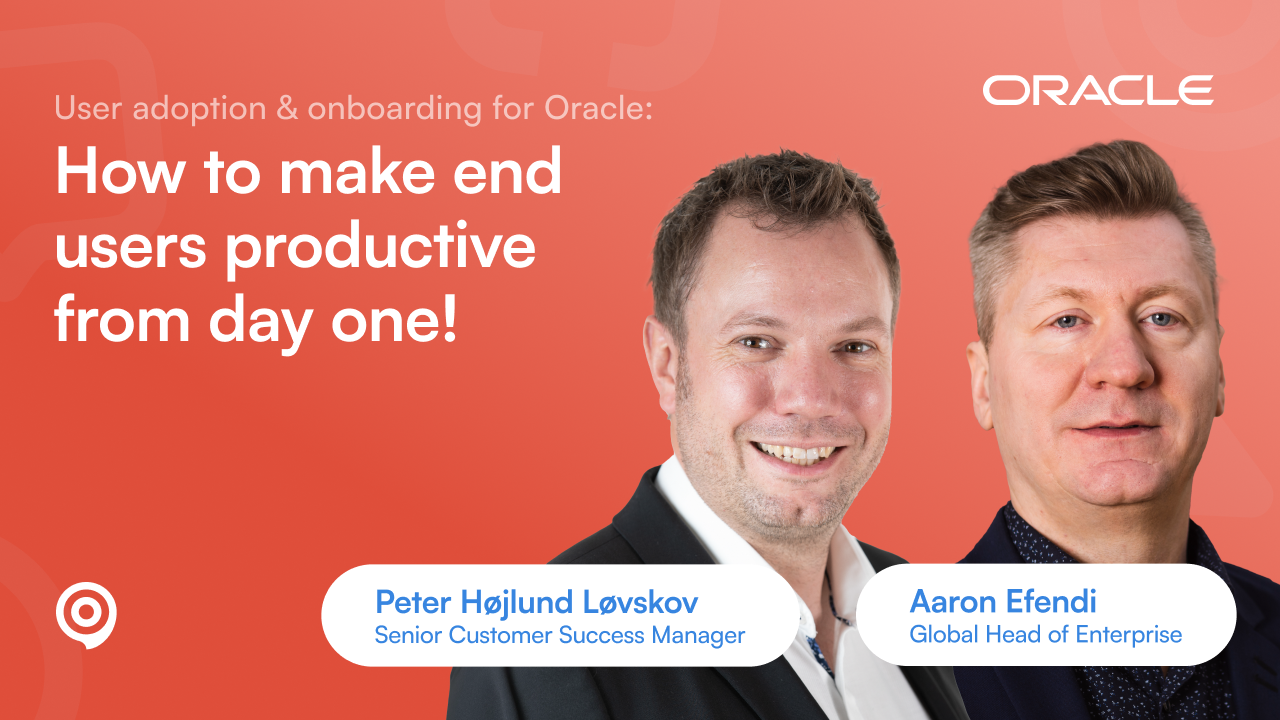Webinar
User Adoption & Onboarding for Oracle: How to Make End Users Productive from Day One

Are you upgrading your current Oracle application or planning to transition to Oracle Cloud? Then tune into our upcoming webinar where we cover how you can ensure success in your Oracle project.
Agenda
- Accelerate your content creation process
- Keep documentation up-to-date
- Auto–translate user instructions into 45+ languages
- Enhance user onboarding experience and productivity
- Test your application’s processes automatically





Oracle onboarding & user adoption: Making end users productive from day one
Achieving successful Oracle ERP user adoption is a critical milestone for any enterprise implementing Oracle applications. End users must not only understand the system – they need to become confident, capable users from the moment they log in. With the right onboarding strategy in place, organizations can shorten learning curves, reduce support burdens, and maximize ROI on their Oracle investment.
Below, we outline key approaches to improving adoption and onboarding across Oracle ERP deployments – tailored specifically for training managers seeking scalable, effective enablement tools.
Why day-one productivity matters for Oracle ERP
For large-scale Oracle implementations, the difference between adoption and resistance often comes down to how users experience the system on day one. If employees feel lost or unsupported, confidence drops quickly – and so does usage.
Focusing on Oracle onboarding that empowers users immediately brings significant benefits:
Faster time to value: Well-trained users begin contributing right away, helping the organization see ROI faster.
Lower support costs: Confident users need less hand-holding from IT or trainers.
Increased satisfaction: Positive first experiences reduce frustration and build user trust in the system.
Higher adoption rates: When users understand the “why” and “how” behind Oracle tasks, they’re more likely to engage with the platform long-term.
Use multi-format training to support all learning styles
One size doesn’t fit all in training, so modern Oracle onboarding uses multiple learning formats to engage every learning style. Different users prefer different formats – some learn best with written step-by-step guides, others with video, and some through hands-on practice. With ClickLearn’s digital adoption solution (as highlighted in the webinar), you can produce a rich variety of training materials from a single recording of an Oracle process. Key formats include:
Step-by-step documents: Traditional Word/PDF guides and PowerPoint slides that walk users through Oracle workflows. These are great for quick reference or classroom training sessions.
Interactive video tutorials: “Show me” videos demonstrate each step without user interaction, while “Try me” simulations let users click through steps in a safe sandbox. “Test me” scenarios even quiz users by having them perform the process, giving a score at the end. These video-based formats are engaging and can be paused or replayed as needed.
In-app live guidance: A guided live assistant (an on-screen avatar) provides real-time help within the actual Oracle application. If a user gets stuck, they can activate the assistant to receive step-by-step guidance through the live process. This means users can complete tasks correctly without leaving the Oracle interface or calling support.
By offering content in text, visual, and interactive forms, you cater to all preferences. New Oracle users can choose the format that suits them best – be it reading a quick manual, watching a how-to video, or following on-screen prompts. This multi-format approach greatly enhances engagement and retention during onboarding.
Why automate training content creation and updates
Manual content creation is time-consuming and often unsustainable – especially when Oracle processes evolve frequently. Using automation to create and update training materials is a game-changer for training teams.
With the right tools, you can:
Record a process once and automatically generate multiple training formats (videos, PDFs, slide decks, interactive simulations).
Quickly update content when Oracle workflows change by replaying and re-recording updated steps – no need to start from scratch.
Scale training output without increasing manual work, empowering smaller teams to support thousands of users.
Automating documentation ensures consistency and reduces the burden of keeping training materials current – both essential for long-term adoption.
Build a scalable, localized, and reliable Oracle ERP onboarding program
For enterprise-wide Oracle ERP user adoption to succeed, onboarding must be more than a one-time training event. It needs to be a scalable, adaptable, and reliable enablement strategy – one that works across global teams, keeps up with system changes, and supports users in every region.
A sustainable onboarding program is built on three essential pillars:
1. Localized, multilingual learning at scale
Oracle ERP deployments often span departments, geographies, and languages. To engage every user, onboarding content must be accessible in their native language and adapted to their local system configuration. Modern training platforms make this possible by enabling:
Multilingual narration and content, so users receive training in the language they understand best
Localized screenshots and terminology that reflect the exact Oracle environment each user sees
Automated translation workflows, which dramatically reduce the effort required to support diverse regions
This kind of localization not only makes training more effective but also shows global employees that their needs are prioritized – fostering trust and improving adoption rates at every level.
2. Validation through automated process testing
Training materials must reflect how processes actually function in Oracle. Automated process testing ensures alignment by validating workflows before and after deployment. When you test recorded processes against the live system, you can:
Detect issues early, before users encounter them
Minimize post-go-live disruptions
Reinforce trust in both the training and the system itself
By tying training and testing together, organizations maintain accuracy and continuity in their onboarding content – even as Oracle updates or customizations roll out.
3. A foundation for sustainable adoption
A modern onboarding approach is:
Scalable, supporting thousands of users across functions and geographies
Adaptable, with content that updates as Oracle workflows evolve
Inclusive, ensuring all users – regardless of role or – can succeed
Interactive, with in-application guidance and self-service support built in
With these pillars in place, your onboarding strategy becomes a powerful driver of long-term Oracle ERP user adoption. You reduce friction, empower employees, and increase the value you get from Oracle – starting on day one and growing with your business.